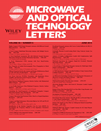Compact and high performance microstrip diplexer for GPS and WLAN application
Abstract
In this article, a novel compact and high performance microstrip diplexer is designed for global position system (GPS) and wireless local area network (WLAN) applications. The compact diplexer consists of two filters with short centered stepped impedance resonators (SCSIRs) and quarter-wavelength resonators (QWRs), operated at 1.575 GHz and 5.8 GHz, respectively. Due to the intrinsic characteristics and mutual loading effect of two filters, multiple transmission zeros can be generated to achieve sharp skirt, wide stopband, and high isolation of the diplexer. Moreover, more compact size can be obtained without the extra junction matching. Finally, a microstrip diplexer with 1 dB absolute bandwidth 100 MHz for GPS channel and 1 dB fractional bandwidth (FBW) of 3.45% at 5.8 GHz for WLAN channel is designed and fabricated. The simulated and measured results show a better agreement and validate the proposed theory. The size without the 50 Ω feedline is only 0.156 λg × 0.103λg, in which λg is the guided wavelength at 1.575 GHz. © 2013 Wiley Periodicals, Inc. Microwave Opt Technol Lett 55:1233–1237, 2013; View this article online at wileyonlinelibrary.com. DOI 10.1002/mop.27550




